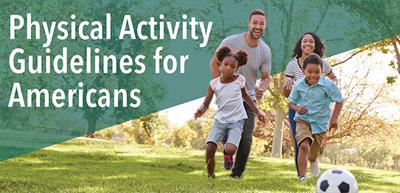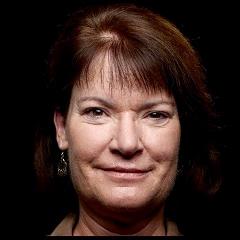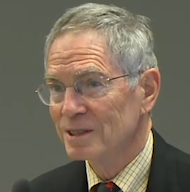Abby King, PhD, FACSM, and Kenneth Powell, MD, MPH, FACSM |
May
15, 2019
The American College of Sports Medicine has published a new collection of papers titled ACSM Scientific Pronouncements: Physical Activity Guidelines for Americans, 2nd Edition. The pronouncements are featured in a special issue of Medicine & Science in Sports & Exercise (MSSE) that published today. The 14 papers included in the collection originated from the work of the Physical Activity Guidelines Scientific Advisory Committee.
 The ACSM pronouncements represent the depth and breadth of the committee’s work, from July 2016 though February 2018, reviewing, interpreting and summarizing the current scientific literature on physical activity and health from a public health perspective. The Committee’s Scientific Report is the foundation for the recently released Physical Activity Guidelines for Americans: 2nd Edition. The pronouncements highlight key topics and evidence from the Committee’s Scientific Report in a format and medium that, for many, will be more familiar and easier to access than the online version of the report. Several of these topic areas such as sedentary behavior, the benefits for children as young as three to five-years-old and the promotion of regular physical activity were not included in the previous 2008 guidelines and its accompanying scientific advisory committee work.
The ACSM pronouncements represent the depth and breadth of the committee’s work, from July 2016 though February 2018, reviewing, interpreting and summarizing the current scientific literature on physical activity and health from a public health perspective. The Committee’s Scientific Report is the foundation for the recently released Physical Activity Guidelines for Americans: 2nd Edition. The pronouncements highlight key topics and evidence from the Committee’s Scientific Report in a format and medium that, for many, will be more familiar and easier to access than the online version of the report. Several of these topic areas such as sedentary behavior, the benefits for children as young as three to five-years-old and the promotion of regular physical activity were not included in the previous 2008 guidelines and its accompanying scientific advisory committee work.
The pronouncements describe a cornucopia of health benefits accompanying regular physical activity for all age groups, including maintenance of a healthy weight, reductions in cardiovascular disease, type-2 diabetes and eight types of cancer, as well as improvements in cognition, perceived quality of life, sleep and energy for daily activities. Together, they provide a summary of the ever-widening range of health benefits attributable to physical activity. The papers also expand the available information about the interactions between sedentary behavior and moderate-to-vigorous physical activity, in addition to topics on the minds of a growing number of Americans, such as the benefits of lighter intensity activity and step counts, as well as high-intensity interval training. Finally, they provide evidence and examples of a wide range of effective physical activity promotion methods, including individual level, community-based and environmental and policy interventions, along with a number of promising information and communication technologies for increasing physical activity.
The ACSM pronouncements highlight not only the benefits of regular physical activity, but also what remains to be learned if the promise of physical activity for the public is to be fully realized. For example, we know that, despite the substantial health benefits that would seem to be within easy reach, many people are not benefiting. We have yet to learn how to assemble the most effective interventions into multifaceted programs that enable, facilitate and encourage people to be more physically active, regardless of their age or current circumstances. We are just beginning to appreciate the relative benefits of different physical activity intensities, ranging from high-intensity intervals to light-intensity activity, as well as the fuller role that sedentary behavior plays in impacting our health. We also are still learning how to best assemble the various types of physical activity across a full 24-hour day to obtain the most benefits.
These areas for future study notwithstanding, the breadth of the current evidence base presents us with a “clarion call” to put into action all that we know now, so that all Americans can receive the health and quality of life benefits that an active lifestyle can bring.
To get started on learning more about the new ACSM Pronouncements, read The U.S. Physical Activity Guidelines Advisory Committee Report—Introduction.
 Abby C. King, PhD, FACSM, Co-Chair, 2018 Physical Activity Guidelines Advisory Committee, is Professor of Health Research & Policy and Medicine at Stanford School of Medicine. Recipient of the Outstanding Scientific Contributions in Health Psychology Award from the American Psychological Association, her research focuses on the development, evaluation, and translation of public health interventions to reduce chronic disease and its key risk factors, including physical inactivity and sedentary behavior. She has developed and evaluated the effectiveness of state-of-the-art communication technologies and community-based participatory research perspectives to address health disparities among disadvantaged populations worldwide. She has served on a number of government taskforces in the U.S. and abroad, including membership on the HHS Scientific Advisory Committee on National Health Promotion and Disease Prevention Objectives for 2020, and the Science Board of the President’s Council on Fitness, Sports & Nutrition. An elected member of the Academy of Behavioral Medicine Research and Past President of the Society of Behavioral Medicine, Dr. King was one of 10 U.S. scientists honored by the Association of American Medical Colleges in 2014 for outstanding research targeting health inequities. Her research on citizen science engagement to promote healthful living environments for all has been honored with an international excellence award.
Abby C. King, PhD, FACSM, Co-Chair, 2018 Physical Activity Guidelines Advisory Committee, is Professor of Health Research & Policy and Medicine at Stanford School of Medicine. Recipient of the Outstanding Scientific Contributions in Health Psychology Award from the American Psychological Association, her research focuses on the development, evaluation, and translation of public health interventions to reduce chronic disease and its key risk factors, including physical inactivity and sedentary behavior. She has developed and evaluated the effectiveness of state-of-the-art communication technologies and community-based participatory research perspectives to address health disparities among disadvantaged populations worldwide. She has served on a number of government taskforces in the U.S. and abroad, including membership on the HHS Scientific Advisory Committee on National Health Promotion and Disease Prevention Objectives for 2020, and the Science Board of the President’s Council on Fitness, Sports & Nutrition. An elected member of the Academy of Behavioral Medicine Research and Past President of the Society of Behavioral Medicine, Dr. King was one of 10 U.S. scientists honored by the Association of American Medical Colleges in 2014 for outstanding research targeting health inequities. Her research on citizen science engagement to promote healthful living environments for all has been honored with an international excellence award.
 Kenneth E. Powell, MD, MPH, FACSM, Co-Chair, 2018 Physical Activity Guidelines Advisory Committee, now retired, was a public health epidemiologist with the CDC and the Georgia Department of Human Resources. The relationship between physical activity and health has been an important theme during his career. He planned, chaired, and edited the papers from the first national workshop on the epidemiologic and public health aspects of physical activity and exercise in 1985. Dr. Powell served on the Institute of Medicine Committee on Physical Activity, Health, Transportation, and Land Use (2005); Committee on Progress in Preventing Childhood Obesity (2008); and Committee on Physical Activity and Physical Education in the School Setting (2013). He was a member of the 2008 Physical Activity Guidelines Advisory Committee and a co-chair of the 2018 Physical Activity Guidelines Advisory Committee. He is a graduate of Harvard College, Northwestern University School of Medicine, and the Harvard School of Public Health.
Kenneth E. Powell, MD, MPH, FACSM, Co-Chair, 2018 Physical Activity Guidelines Advisory Committee, now retired, was a public health epidemiologist with the CDC and the Georgia Department of Human Resources. The relationship between physical activity and health has been an important theme during his career. He planned, chaired, and edited the papers from the first national workshop on the epidemiologic and public health aspects of physical activity and exercise in 1985. Dr. Powell served on the Institute of Medicine Committee on Physical Activity, Health, Transportation, and Land Use (2005); Committee on Progress in Preventing Childhood Obesity (2008); and Committee on Physical Activity and Physical Education in the School Setting (2013). He was a member of the 2008 Physical Activity Guidelines Advisory Committee and a co-chair of the 2018 Physical Activity Guidelines Advisory Committee. He is a graduate of Harvard College, Northwestern University School of Medicine, and the Harvard School of Public Health.